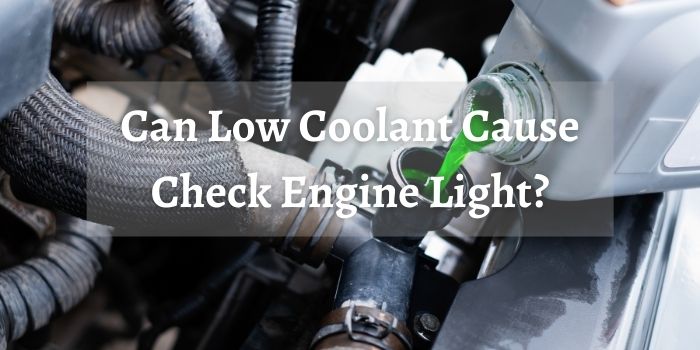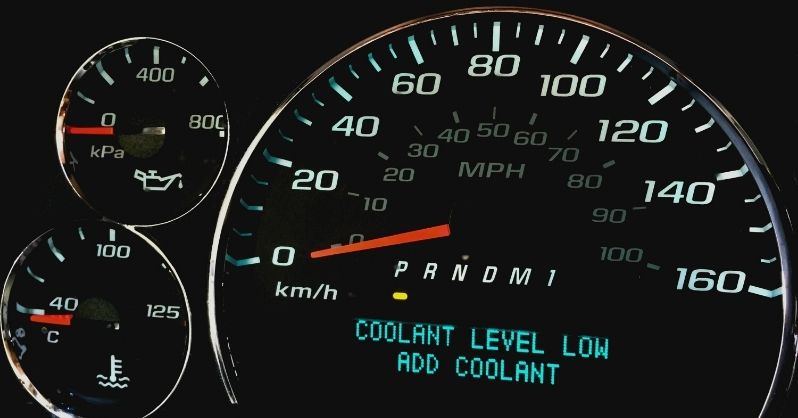If you’re like most car owners, you probably check your coolant level pretty regularly. You know that if it gets too low, it can cause all sorts of problems.
So, can low coolant cause check engine light?
It can! If you’ve been experiencing this problem, be sure to check your coolant level and make sure it’s topped up. If it is, then there might be another issue causing the Check Engine light to come on.
In any case, it’s always best to take your car in for a diagnostic test to find out what’s going on.

Reasons Why Low Coolant Causes Check Engine Light to Come On
There are a few reasons that can be responsible for causing the check engine light to come on when the coolant gets low. They’re as follows-
Rise or Fall of Temperature
When the temperature outside falls, the coolant in your engine becomes thicker and doesn’t flow as easily. This can cause low coolant levels, which triggers the check engine light.
In extreme cold, the coolant can actually freeze, leading to serious engine damage.
Similarly, when the temperature goes up, the cooling system needs to work more to keep the engine at a stable temperature. This can cause low coolant levels and trigger the check engine light.
Miscommunication
Miscommunication can happen when the coolant level sensor is faulty and sends the wrong signal to the car’s computer.
As a result, the computer thinks that the engine is overheating and triggers the check engine light. In addition, miscommunication can also occur if there is a problem with the oxygen sensor or exhaust gas recirculation system.
If either of these systems is not functioning properly, it can cause the check engine light to come on.
No Dedicated Light
One common reason the check engine light comes on is that there is no dedicated light or gauge for coolant. Therefore, it can be difficult to know when the level is low.
As a result, the check engine light will often come on as a warning that the coolant level is getting low.
What Happens When The Coolant Gets Low in The Car? What Light Comes On When Coolant Is Low?
The engine in your car needs to be kept at a certain temperature in order for it to run properly. This is done by a mixture of water and coolant flowing through the engine. Also, it’s important to know how much time to let engine cool before adding coolant.
If the level of coolant gets too low, it will no longer be able to effectively keep the engine cool. As a result, the engine will start to overheat.
This can cause serious damage to the engine, including warping of metal parts and cracking of the engine block. In extreme cases, it can even cause the engine to seize up completely.
To indicate that the coolant is low, you’ll see the low coolant light come on.
This light looks like a thermometer in a bubbling liquid, and it’s usually located on the dashboard near the speedometer.
What are the Signs of Low Coolant?

When your car’s coolant is lower it’ll show you some obvious signs which are mentioned below. Take a quick look-
Unusual Fluctuation in Temperature
One of the most important things to keep an eye on in your car is the temperature sensor. If it starts to fluctuate unexpectedly, that’s usually a sign that there’s something wrong with the engine coolant.
Coolant helps to regulate the temperature of your engine, so if there’s a leak or other problem, it can cause the temperature to fluctuate. In some cases, this can lead to serious engine damage.
Warning Light Turned On
When your car’s power control module (PCM) detects that the engine coolant temperature is too low, it will turn on the warning light.
However, if the coolant temperature sensor is damaged, the PCM may not receive the correct information.
Therefore, miscommunication might cause the warning light to come on. In addition, some cars do not have a dedicated warning light for low coolant levels.
Trembling Ride
One symptom of a low coolant level is a trembling ride. If the coolant level drops below a certain point, it can no longer effectively dissipate heat, causing the engine to run hot.
As the engine heats up, it begins to vibrate more violently, which is transmitted through the frame of the car and can be felt by passengers.
Engine Shut Down
Your car’s engine relies on many different thermodynamic principles in order to function properly. One of these principles is the equilibrium between the cooling system and the engine itself.
If the level of coolant in the system falls too low, it can cause the engine to shut down abruptly. This is because the low coolant level disrupts the equilibrium, causing the engine to overheat.
How To Fix Low Coolant In Your Car?
If you’ve successfully diagnosed the symptoms that your car is exhibiting and if it’s because of the low coolant then you might need to follow the guidance below.
Keeping it Fully Loaded
One way to fix a low coolant issue in your car is to keep the coolant fully loaded.
The coolant helps to keep the engine at a safe temperature, and if it gets too low, the engine can overheat. overheating can cause serious damage to the engine, and it can also be dangerous for the driver and passengers.
To keep the coolant fully loaded, check the level regularly and top it off as needed. You may also want to consider adding an extra bottle of coolant to your trunk in case of emergencies.
Being Patient
If your engine error light is still on after you’ve loaded the coolant, it’s important to be patient and wait for the recovery time that the sensors need.
Depending on the severity of the error, it could take a few minutes for the light to turn off. In some cases, it may take a few days or even weeks.
However, if you continue to drive your car without giving the sensors time to recover, you run the risk of causing further damage to your engine.
Keeping an Eye on the Regulator
Most people think that once the coolant is full, they can forget about the engine regulator. However, this is not the case.
The engine might yet be harmed because of low coolant, and the regulator helps to keep the coolant level where it needs to be.
Because a regulator controls the pump that circulates the coolant through the engine.
It also limits the amount of pressure in the system and allows the engine to heat up faster and reach operating temperature more quickly.
If the regulator malfunctions, it can cause improper coolant function. As a result, the engine can overheat, leading to serious damage.
Will Low Coolant Throw a Code?
Yes, the low coolant will throw a code. The P0128 code is triggered when the engine coolant temperature fails to reach the proper operating temperature within a set amount of time after the engine is started.
FAQs
1. How Long Can An Engine Run With Low Coolant?
Coolant helps to transfer heat away from the engine and keeps it at a safe operating temperature. If the coolant level gets low, it can cause the engine to overheat. In some cases, an engine can run for a short period of time without coolant before it becomes damaged.
2. Can Low Coolant Make Your Car Run Rough?
The coolant helps to keep the engine at a constant temperature, so when it starts to get low, the engine can get too hot or too cold, which can cause it to run rough. In extreme cases, low coolant can even cause the engine to seize up.
3. Is It Normal For Coolant To Get Low?
When your engine is running, the coolant heats up and expands. When it’s turned off, the coolant contracts and a small amount is used up in the process.
The coolant level will be lower when the engine is cold. However, if you find yourself adding large amounts of fluid frequently, then it might not be the usual case.
Final Thoughts
Hope I’ve clearly answered your question, can low coolant cause check engine light.
Low coolant can cause your engine to overheat, which will trip the check engine light. Make sure you keep a close eye on your fluid levels and top off as necessary and you should be good to go!